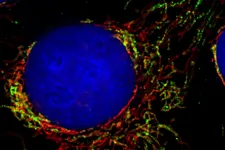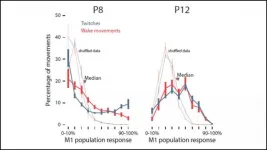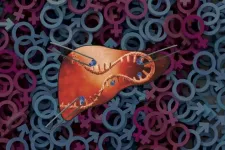(Press-News.org) Researchers at the University of Maryland School of Medicine (UMSOM) launched a new online tool that could more quickly advance medical discoveries to reverse progressive hearing loss. The tool enables easy access to genetic and other molecular data from hundreds of technical research studies involving hearing function and the ear. The research portal called gene Expression Analysis Resource (gEAR) was unveiled in a study last month in Nature Methods. It is operated by a group of physician-scientists at the UMSOM Institute for Genome Sciences (IGS) in collaboration with their colleagues at other institutions.
The portal allows researchers to rapidly access data and provides easily interpreted visualizations of datasets. Scientists can also input their own data and compare it to other datasets to help determine the significance of their new finding.
"It saves scientists a huge amount of time," said study corresponding author Ronna Hertzano, MD, PhD, Associate Professor of Otorhinolaryngology-Head & Neck Surgery at UMSOM and founder of the gEAR. "Instead of relying only on identifying mutations in genes for hearing loss, researchers can easily identify which cells express any gene in the ear, and how this expression changes, for example, as a result of noise exposure or in processes of regeneration in other species."
Dr. Hertzano and her team recently added data from the BRAIN initiative to a specialized domain of the gEAR portal to provide access to those performing neuroscience studies to better understand brain function and neurodegenerative diseases like Alzheimer's. The portal is free and available to any researcher seeking access.
Users of the portal can do a variety of applications depending on their needs. They can access the dataset uploader and add their dataset into gEAR to view their data in a private setting. This enables them to see their findings in the context of other public data before posting their results online or submitting their paper for publication. Once a manuscript is published, a permalink can be included in the manuscript which links readers directly to a curated view of that dataset.
"The gEAR portal currently includes over 800 datasets, which we carefully reviewed before inputting," said Dr. Hertzano. "We currently have more than 1,200 registered users and over 80 citations in research studies. We are expecting a large increase now that our methods paper is published." She and her colleagues did a soft launch of the portal a few years earlier and publicized its existence via discussions with colleagues and user workshops at scientific meetings.
The Hearing Restoration Project, a non-profit research consortium funded by the Hearing Health Foundation, provided initial support of gEAR in an effort to better understand the mystery of hair cell regeneration - why hair cells in the ear regenerate in certain animals but not in humans. Our hair cells do not naturally regenerate when they die off due to aging, excess noise, or exposure to certain potent medications like chemotherapy drugs for cancer. For this reason, hearing loss is usually permanent and cannot be reversed. The consortium uses genomic analyses to compare molecular processes in species that do not regenerate hair cells. "The gEAR team closely interacts with the consortium researchers who also serve as our focus group, providing priceless feedback and suggestions," Dr. Hertzano said.
Understanding how the expression of certain genes plays a role in hair cell regeneration - and how enzymes and other proteins mediate that process - could lead to new treatments to reverse hearing loss by triggering a regeneration of these cells.
"By enabling rapid access to enormous datasets, the gEAR portal can serve as a valuable hub for community building around common research areas," said Claire M. Fraser, PhD, the Dean's Endowed Professor of Medicine, Microbiology and Immunology, and Director of IGS. "Having access to data in large repositories is not enough. What's essential is that gEAR curates and organizes the data into an accessible format so it can be used to address important scientific questions."
Study lead author Joshua Orvis, Lead Bioinformatics Software Engineer at IGS and study co-author Yang Song, PhD, Bioinformatics Analyst II at IGS, were instrumental in the development of gEAR. Researchers from the University of Maryland, College Park, National Institute on Deafness and Other Communication Disorders, University of Iowa, Johns Hopkins University School of Medicine, and Bar-Ilan University in Israel also contributed to this study.
"The gEAR portal is a beautiful example of the value of close collaboration of clinicians, biologists, and engineers to bridge the gap in technology and make the critically important 'omic' data generated across the world immediately accessible to biologists in a meaningful format," said E. Albert Reece, MD, PhD, MBA, Executive Vice President for Medical Affairs, UM Baltimore, and the John Z. and Akiko K. Bowers Distinguished Professor, and Dean, University of Maryland School of Medicine.
INFORMATION:
The gEAR portal's development has been funded by the National Institute on Deafness and Other Communication Disorders (NIDCD) and National Institute of Mental Health (NIMH), part of the National Institutes of Health (NIH), and the Hearing Restoration Project (HRP), part of the Hearing Health Foundation (HHF).
About the University of Maryland School of Medicine
Now in its third century, the University of Maryland School of Medicine was chartered in 1807 as the first public medical school in the United States. It continues today as one of the fastest growing, top-tier biomedical research enterprises in the world -- with 45 academic departments, centers, institutes, and programs; and a faculty of more than 3,000 physicians, scientists, and allied health professionals, including members of the National Academy of Medicine and the National Academy of Sciences, and a distinguished two-time winner of the Albert E. Lasker Award in Medical Research. With an operating budget of more than $1.2 billion, the School of Medicine works closely in partnership with the University of Maryland Medical Center and Medical System to provide research-intensive, academic and clinically based care for nearly 2 million patients each year. The School of Medicine has more than $563 million in extramural funding, with most of its academic departments highly ranked among all medical schools in the nation in research funding. As one of the seven professional schools that make up the University of Maryland, Baltimore campus, the School of Medicine has a total population of nearly 9,000 faculty and staff, including 2,500 student trainees, residents, and fellows. The combined School of Medicine and Medical System ("University of Maryland Medicine") has an annual budget of nearly $6 billion and an economic impact more than $15 billion on the state and local community. The School of Medicine, which ranks as the 8th highest among public medical schools in research productivity, is an innovator in translational medicine, with 600 active patents and 24 start-up companies. The School of Medicine works locally, nationally, and globally, with research and treatment facilities in 36 countries around the world. Visit END
New Curtin University-led research has called into question existing health advice that mothers wait a minimum of two years after giving birth to become pregnant again, in order to reduce the risk of adverse pregnancy outcomes, such as preterm and small-for-gestational age births.
The research found that a World Health Organization (WHO) recommendation to wait at least 24 months to conceive after a previous birth may be unnecessarily long for mothers in high-income countries such as Australia, Finland, Norway and the United States.
Lead researcher ...
Errors in the metabolic processes of mitochondria are responsible for a variety of diseases such as Parkinson's and Alzheimer's. Scientists needed to find out just how the necessary building blocks are imported into the complex biochemical apparatus of these cell areas. The TOM complex (translocase of the outer mitochondrial membrane) is considered the gateway to the mitochondrion, the proverbial powerhouse of the cell. The working group headed by Professor Chris Meisinger at the Institute of Biochemistry and Molecular Biology at the University of Freiburg has now demonstrated - in human cells - how signaling molecules control this gate. A signaling protein called DYRK1A modifies the molecular machinery of TOM and makes it more permeable ...
Three decades ago, child development researchers found that low-income children heard tens of millions fewer words in their homes than their more affluent peers by the time they reached kindergarten. This "word gap" was and continues to be linked to a socioeconomic disparity in academic achievement.
While parenting deficiencies have long been blamed for the word gap, new research from the University of California, Berkeley, implicates the economic context in which parenting takes place -- in other words, the wealth gap.
The findings, published this month in the journal Developmental Science, provide the first evidence that parents may talk less to their kids when experiencing financial scarcity.
"We were interested in what happens when parents think about or experience financial scarcity ...
Electrical activity in the motor cortex of rats transforms from redundant to complex over the span of four days shortly after birth. Sleep twitches guide this metamorphosis, according to new research published in JNeurosci.
Despite its name, the motor cortex doesn't control movement right off the bat. Early in development, this part of the brain is solely a sensory structure. Feedback from self-generated movements -- sleep twitches in particular -- may build representations of the body that will later orchestrate movement.
To characterize this transition, Glanz et al. recorded electrical activity from the motor cortex of rat pups eight and 12 days after birth while monitoring their behavior. ...
Politicians may have good reason to turn to angry rhetoric, according to research led by political scientists from Colorado--the strategy seems to work, at least in the short term.
In a new study, Carey Stapleton at the University of Colorado Boulder and Ryan Dawkins at the U.S. Air Force Academy discovered that political furor may spread easily: Ordinary citizens can start to mirror the angry emotions of the politicians they read about in the news. Such "emotional contagion" might even drive some voters who would otherwise tune out of politics to head to the polls.
"Politicians want to get reelected, and anger is a powerful tool that they can use to make that happen," said Stapleton, who recently earned his PhD in political science at ...
ROCHESTER, Minn. -- Did you know multiple sclerosis (MS) means multiple scars? New research shows that the brain and spinal cord scars in people with MS may offer clues to why they developprogressive disability but those with related diseases where the immune system attacks the central nervous system do not.
In a study published in Neurology, Mayo Clinic researchers and colleagues assessed if inflammation leads to permanent scarring in these three diseases:
MS.
Aquaporin-4 antibody positive neuromyelitis optica spectrum disorder (AQP4-NMOSD).
Myelin oligodendrocyte glycoprotein antibody associated disorder (MOGAD).
They also studied whether scarring may be a reason for ...
For decades, researchers around the world have searched for ways to use solar power to generate the key reaction for producing hydrogen as a clean energy source -- splitting water molecules to form hydrogen and oxygen. However, such efforts have mostly failed because doing it well was too costly, and trying to do it at a low cost led to poor performance.
Now, researchers from The University of Texas at Austin have found a low-cost way to solve one half of the equation, using sunlight to efficiently split off oxygen molecules from water. The finding, published recently in Nature Communications, represents a step forward toward greater adoption ...
GAINESVILLE, Fla. --- Plants are DNA hoarders. Adhering to the maxim of never throwing anything out that might be useful later, they often duplicate their entire genome and hang on to the added genetic baggage. All those extra genes are then free to mutate and produce new physical traits, hastening the tempo of evolution.
A new study shows that such duplication events have been vitally important throughout the evolutionary history of gymnosperms, a diverse group of seed plants that includes pines, cypresses, sequoias, ginkgos and cycads. Published today in Nature Plants, the research indicates that ...
FINDINGS
A chemical modification that occurs in some RNA molecules as they carry genetic instructions from DNA to cells' protein-making machinery may offer protection against non-alcoholic fatty liver, a condition that results from a build-up of fat in the liver and can lead to advanced liver disease, according to a new study by UCLA researchers.
The study, conducted in mice, also suggests that this modification -- known as m6A, in which a methyl group attaches to an RNA chain -- may occur at a different rate in females than it does in males, potentially explaining why females tend to have higher fat content in the liver. The researchers found that without the m6A modification, differences in liver fat content between the sexes were reduced dramatically.
In ...
WOODS HOLE, Mass. - What's a hungry marine microbe to do when the pickings are slim? It must capture nutrients - nitrogen, phosphorus, or iron - to survive, yet in vast expanses of the ocean, nutrients are extremely scarce. And the stakes are high: Marine microbial communities drive many of the elemental cycles that sustain all life on Earth.
One ingenious solution to this challenge is reported this week in Proceedings of the National Academy of Sciences. In low-nutrient environments, marine microbes can clump together and hook up with even tinier cells that have vibrating, hairlike appendages (cilia) on their surface. ...




